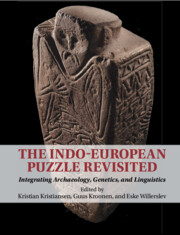Book contents
- The Indo-European Puzzle Revisited
- The Indo-European Puzzle Revisited
- Copyright page
- Contents
- Figures
- Tables
- Contributors
- Preface
- Introduction
- Part I Early Indo-European and the Origin of Pastoralism
- Part II Migratory Processes and Linguistic Dispersals between Yamnaya and the Corded Ware
- Part III The Cultural and Linguistic Significance of Bell Beakers along the Atlantic Fringe
- Part IV The Bronze Age Chariot and Wool Horizons
- 14 Relative and Absolute Chronologies of the Chariot Complex in Northern Eurasia and Early Indo-European Migrations
- 15 Indo-European and Indo-Iranian Wagon Terminology and the Date of the Indo-Iranian Split
- 16 Fire and Water: The Bronze Age of the Southern Urals and the Rigveda
- 17 Wool Fibers of the Northern Eurasian Bronze Age: The Cultural and Geographical Contexts
- 18 An Archaeolinguistic Approach to Indo-European Wool Terminology
- Part V Kinship Systems, Marriage, Fosterage, Free, and Unfree
- Concluding Reflections
- Index
- References
16 - Fire and Water: The Bronze Age of the Southern Urals and the Rigveda
from Part IV - The Bronze Age Chariot and Wool Horizons
Published online by Cambridge University Press: 29 April 2023
- The Indo-European Puzzle Revisited
- The Indo-European Puzzle Revisited
- Copyright page
- Contents
- Figures
- Tables
- Contributors
- Preface
- Introduction
- Part I Early Indo-European and the Origin of Pastoralism
- Part II Migratory Processes and Linguistic Dispersals between Yamnaya and the Corded Ware
- Part III The Cultural and Linguistic Significance of Bell Beakers along the Atlantic Fringe
- Part IV The Bronze Age Chariot and Wool Horizons
- 14 Relative and Absolute Chronologies of the Chariot Complex in Northern Eurasia and Early Indo-European Migrations
- 15 Indo-European and Indo-Iranian Wagon Terminology and the Date of the Indo-Iranian Split
- 16 Fire and Water: The Bronze Age of the Southern Urals and the Rigveda
- 17 Wool Fibers of the Northern Eurasian Bronze Age: The Cultural and Geographical Contexts
- 18 An Archaeolinguistic Approach to Indo-European Wool Terminology
- Part V Kinship Systems, Marriage, Fosterage, Free, and Unfree
- Concluding Reflections
- Index
- References
Summary
It does not often happen that linguistic and archaeological sources allow the creation of a coherent narrative: they are usually separated from each other in time and space and do not meet the necessary prerequisites for a comparative analysis. The archaeological facts must form a clear pattern and demonstrate the existence of a cultural stereotype; the linguistic attribution of the population to which the analyzed archaeological sites belong must be uncontroversial; and, finally, the linguistic sources must provide sufficient information about that cultural stereotype.
- Type
- Chapter
- Information
- The Indo-European Puzzle RevisitedIntegrating Archaeology, Genetics, and Linguistics, pp. 263 - 274Publisher: Cambridge University PressPrint publication year: 2023



